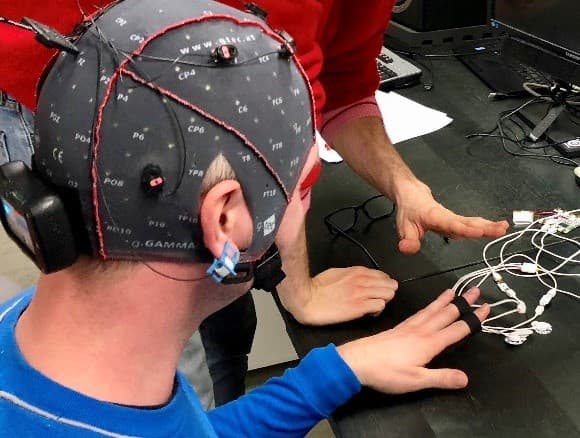How I got the internship
I have always been interested in merging different fields and applying knowledge beyond the focus of the material. This is how I found about neurocinema, the research paradigm that merges filmography and neuroscience. About more than a year ago, I attended a talk by Prof. Pia Tikka, a filmmaker and neuroscientist, who at the time was working at the Aalto University in Helsinki. Her work and enthusiasm in both of the fields sparked my interest to explore this blend and find out more about it.
During my bachelor studies, I had carried out a research study with my colleagues that involved one of the pioneering studies in cinematography ‘The Kuleshov effect’ which also proved my interest in merging visuals and cognition. Professor Tikka was happy to hear about my background and accepted my application for a three-month internship at her current research group at Tallinn University in Estonia.
Work tasks and professional development
During my internship, I had the chance to work on a research project that merged several disciplines such as cognitive neuroscience, virtual reality, machine learning, physiology and social sciences. The aim of the study was to develop virtual characters and elicit empathy in people towards them while at the same time assess people’s physiological activity and their personality and empathy traits. Therefore, during the course of three months, I worked towards the finalization of details of the research study, preparation of the experimental paradigm and setup which was followed by executing the pilot data collection and analysis. Last but not least, the final week of my internship took place in Aarhus in Denmark, where at the annual ‘Worlding the brain’ interdisciplinary conference, I presented the ongoing research of my group.
- My internship tasks helped me to apply and improve my literature research skills by combining the results of studies from different fields into a common research focus.
- The experimental paradigm setup was done with PsychoPy, a program used for setting up questionnaires and various stimuli with which I worked for the first time.
- The data collection included physiological data measurements such as electroencephalography (EEG), heart rate and skin conductance. While I had prior knowledge of EEG setup, the heart rate and skin conductance were a novel task for me. The data collection helped me to pick up a more efficient pace of EEG setup, as well as introduced me to the programs g.Nautilus (EEG measurement) and OpenSignals (heart rate and skin conductance measurements).
During the last two weeks of my internship, I focused on sorting the collected data and doing a preliminary analysis as well as the preparation of my final presentation. Presenting the study both in front of my research department at the University of Tallinn and the scholars coming from various fields acquired me to prepare my speech for an audience coming from a very diverse background. Therefore, I dedicated several days to find a way of explaining the complex experimental setup and aim of the study in a concise and simpler, yet academic way. During the course of the conference, I got to talk to many researchers applying neuroscience from different fields and made valuable connections.
In addition to my work in Tallinn and the conference in Aarhus, my internship colleague and I spent a week in Helsinki, doing data collection at the University of Aarhus. The research project is an ongoing collaboration of my supervisor and her previous research group colleagues that required physiological (heart rate and skin conductance) and well as eye-tracking setup. This was a great opportunity for me to learn about eye-tracking not only set up but also monitoring the real-time correction of data collection.
Personal development
During my internship, especially on the sunny days of September, I got to know the city, meet many people, and make valuable friendships both internationals and Estonians. This helped me learn more about the local places of Tallinn, the Estonian culture, history and appreciate the nature surrounding Tallinn. During my stay in Helsinki and Aarhus, I had the chance to learn more about the cities, meet people and visit several museums.
Tallinn
Tallinn is a cosy, small capital located in the north of Estonia. With a population less than a half a million with the high international community, it is a cultural buffet. Located on the coast of the Baltic sea, it is just a few hours away by ferry from Helsinki and St. Petersburg and 4 hours away from Riga. Estonian is the official language, however, the elderly tend to speak both Estonian and Russian, while the younger generations Estonian and English. The large international community has made the city very tourist friendly, and since almost everyone speaks English, it’s very easy to get around, be it in the shopping mall, dancing classes, restaurants or even just asking for directions. The locals are polite and helpful, however, don’t expect them to be very friendly and outgoing at first, as they take their time to feel comfortable and open with people. Anyhow, if you have cracked the first few layers, you have a friend for life.
The living expenses in Tallinn vary from 200-300 EUR for accommodation and another 150-200 EUR for groceries. One should also include socializing and nightlife into the budget which is very similar to prices in Bremen.




Neueste Kommentare